11 September, 2002
9/11/02
Fieldwork and Blood Loss
It has been one of the great fortunes of this program that it seems like I
learn something or experience something new every day. Today I learned that
mushrooms grow here on the tundra. Its not that I didn't actually know that
mushrooms could survive here, but rather that I never even considered the
possibility that this could be a survivable ecosystem for a fungus. While out
placing insects in controlled habitats this morning, I stepped over a small
mushroom before realizing what I had seen. When I did make the connection a
few seconds later, I got down to ground level to take a look. I'm sure that I
looked pretty silly paying so much attention to such a small example of a
fungus, but it amazed me nonetheless.
My second new experience of the day was an introduction to Arctic mosquitoes.
Our test site for the morning was just above the banks of the Sag River. The
wetland areas around the river apparently provide excellent mosquito habitat.
So for about two hours, we were forced to fend of small buzzing bloodsuckers
while we placed our beetle habitats. I have been in many places where the
mosquitoes were viscous and the Sag River mosquitoes are as nasty as in any
of those places. Now several hours later, I find that I have at least a dozen
medium to large welts where I donated blood to the mosquito population this
morning. The morning's experience makes me very grateful for having missed
peak mosquito season earlier in the summer.
The work for the day was to collect and place Click Beetles into controlled
artificial habitats, where they can be recovered in the spring. At six spots,
we placed approximately thirty Click Beetles into small Gladware containers.
We then placed the containers under the rocks where we had originally found
the beetles. The sites were marked with a steel post and pink flagging tape
so they could be found and recovered from below the snow in the spring. The
final task was to wire three of the containers to a temperature data logger.
The data loggers are small electronic recording devices that will record and
store temperature data until recovered in the spring. These parcticular
loggers have to sampling ports that allow us to measure both air temperatures
and the temperatures of the soil under the rocks. Our data in the spring
showed us that while air temperatures in the winter got as low as low as -45
degrees Celsius, temperatures under the rocks got no lower that -15 degrees
Celsius. From these temperatures, we can see that a beetle's selection of a
spot for over-wintering is a critical factor in its survival.
With the placement of the last beetle container, we left the site as quickly
as possible to escape the mosquitoes. We took a few moments on the way back
to the station to pull to the side of the road and get some photographs of a
small Caribou herd. A large mall and several females crossed the road about
200 yards in front of us and moved off toward the mountains. We've seen a few
Caribou in the last few days, but certainly not the hundreds that we saw in
the spring.
The clouds coming over the mountains appeared to be turning a darker, more
ominous shade so we scheduled lab work for the afternoon. Our lab work
consists mostly of determining the actual freezing points of the beetles and
determining the freezing and melting points of the beetle's hemolymph
(blood).With these two tests we can check for the degree of antifreeze
protein activity in the beetles. Its not the same as being out collecting or
lacing the beetles but we do have a wonderful view of Toolik Lake and the
mountains from our lab window. After dinner we will be completing a few more
tests in the lab. Our goal is to have enough done that we can head to the
Atigun River tomorrow to look for new insects to use in the study.
I'll pass the results of that search on tomorrow.
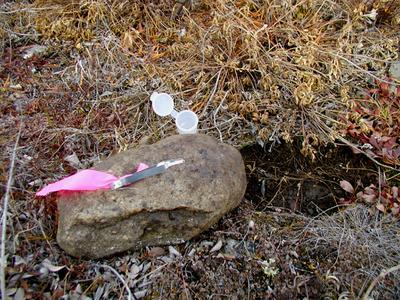
The forceps and plastic jar are our standard collecting tools for the field. The rock they are resting on has just been turned over and the hole beneath checked for beetles. The forceps have a bright tag on them so they do not get lost in the mats of tundra plants all around.
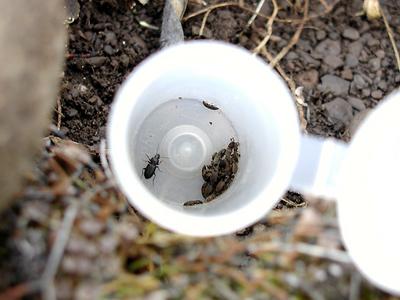
These are a sample of collected beetles. The beetle to the left is a Carabid and the small beetles on the right are Click Beetles.

The controlled habitat for our sample beetles are small Gladware containers dug into the soil and placed under a medium to large rock.

The containers must be packed tightly into the soil.
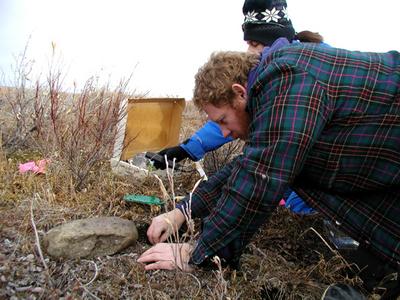
Collecting and placing the beetles requires spending a lot of time on hands and knees close to the ground. Todd is covering this container before we replace the rock.
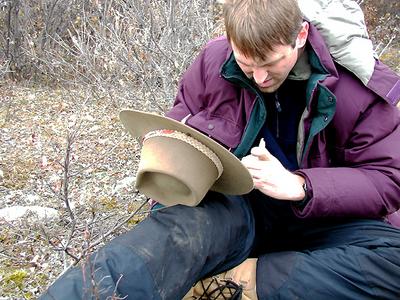
We encountered a problem with the wind blowing away our little Click beetles while we were counting them to put into the containers. I found that my hat worked as an effective windscreen.
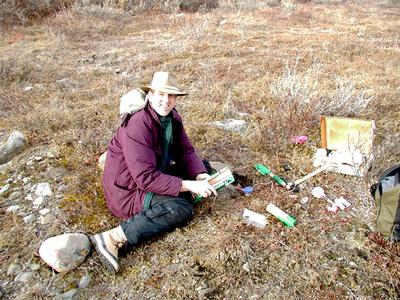
I am still smiling here because it was just before the wind died down and the mosquitoes moved in.
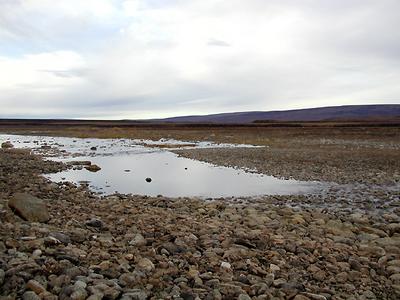
The Sag River gets all of its water from the melting snow of the Brooks Range Mountains. At times the flow is strong enough to carry bits of the mountain away as well. All of these rocks have been carried many miles away from the mountains to be deposited along the path of the Sag.

On our way back to the station, this small group of Caribou passed in front of us.
Contact the TEA in the field at
.
If you cannot connect through your browser, copy the
TEA's e-mail address in the "To:" line of
your favorite e-mail package.
|
